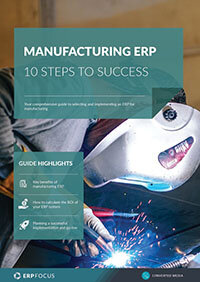4 ways ERP can create a lean supply chain
In business, lean means eliminating waste. Waste can be seen in manufacturing and office practices and is also found in the supply chain, but too few businesses use lean ERP processes to focus on supply chain waste. The final principle of lean is to strive for perfection; almost all of us have some waste in our supply chain to find and eliminate.
1. Customer relationship forecasting
Lean supply chains are customer-centric. Your ERP has modules to manage both customer relationships and supplier relationships. Use customer relationship management (CRM) to go beyond prospecting for new business. Contact your customers regularly to inquire about expected and suspected changes to order patterns and to discuss how you and your customer can work together for mutual benefit. Integrate your ERP with their order management system to see, as a minimum, planned orders from their side.
2. Integrated business intelligence
Lean ERP can integrate business intelligence from all sources. You might have macro-economic forecasts and point-of-sale data that can be combined with data from your customers to develop more powerful order forecasts.
3. Supplier performance measurement
Use your supplier relationship management (SRM) module to learn what changes your suppliers see or are forecasting. Much of these changes might seem to be soft data but, when combined, can become valuable predictors.
Recommended reading: manufacturing ERP - 10 steps to success
Look at the value stream from your customer’s perspective. Do all your purchasing activities add value? Do all your supplier’s activities add value? Use supplier audits to check how well they have eliminated waste. Record your findings in your ERP SRM module and agree improvement targets. Integrate your SRM with their communications systems to allow them to report on their progress. Share the improvements with customers to demonstrate your desire to reduce your selling price and improve your delivery to them.
What can you expect? Longer, better relationships with your suppliers and customers. Lower costs, both for the products and the transactions involved.
It is important to monitor supplier performance in your ERP from all directions. How many orders? How many lines? Which delivery targets have been met and missed? How much time is needed from placing an order to receipt of that material ready for your use? What unnecessary processes are you using; are they using unnecessary processes that add no value? Answering these questions will allow you to reduce your transaction costs to the lowest possible amount.
4. Supply chain modelling
Just-in-time delivery is only one model of eliminating waste through a lean supply chain. Can you change your supply-chain model to a pull system? What do you and your supplier need to do to become more responsive? ERP is already a repository of your transactions. It can be expanded using user-defined tables and fields to store exactly the data you require and support the supply chain model you wish to pursue.
What can you expect? Longer, better relationships with your suppliers and customers. Lower costs, both for the products and the transactions involved. Better forecasting, which your supply chain will be able to use to help your customers add value. Higher profits for all and the ability to responsively manage any change that comes around the corner. Win-win.
Free white paper

Manufacturing ERP: 10 steps to success
Complete step-by-step guide to manufacturing ERP software

Related articles
-

3 causes of ERP supply chain management failure
Supply chains can fail for any number of reason, many of which are beyond our control. We can, ho...
-

Secret KPI: Why Your ERP Implementation Team Matters More Than Software
Learn how Godlan ensures successful ERP implementation for manufacturers with proven strategies &...
-

Process manufacturing ERP: formulas and recipes
Find out about the challenges your process manufacturing ERP will face when it comes to recipes a...

